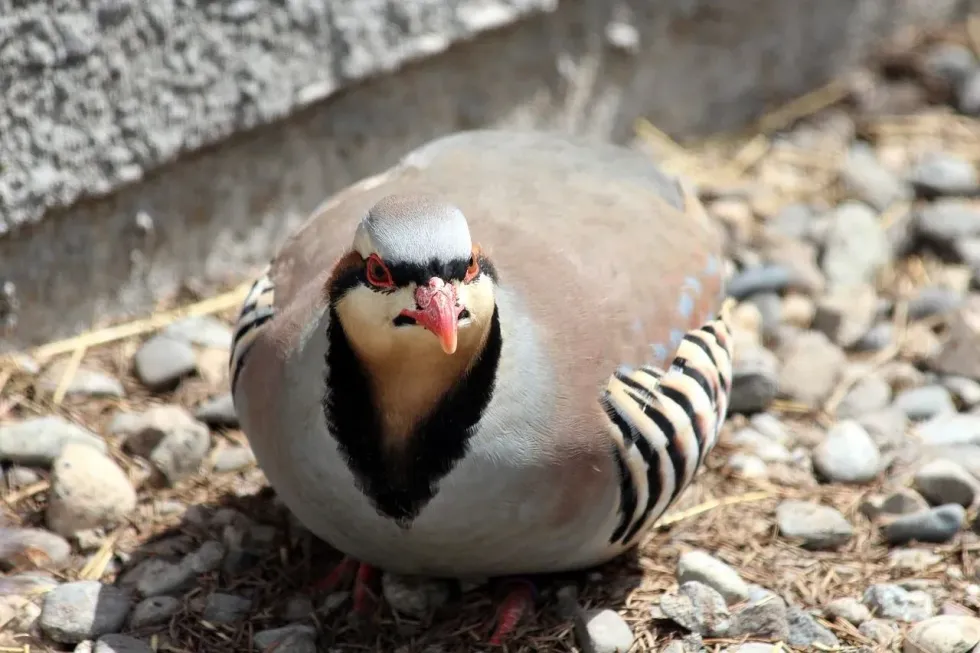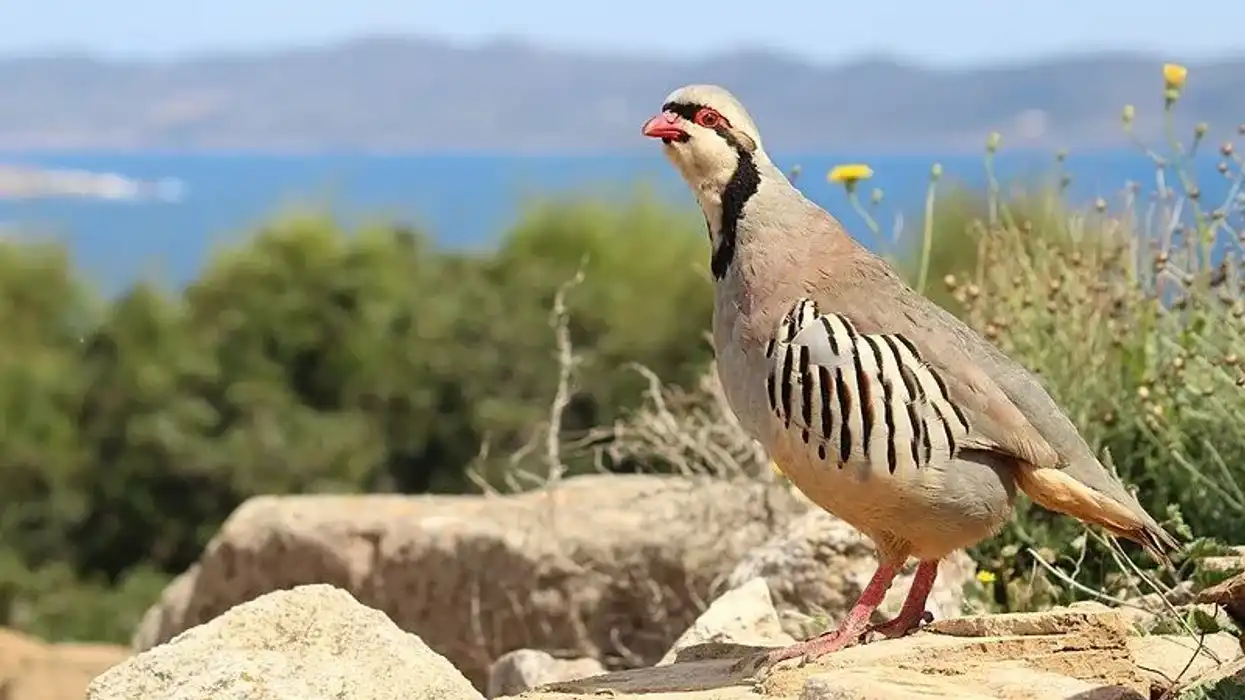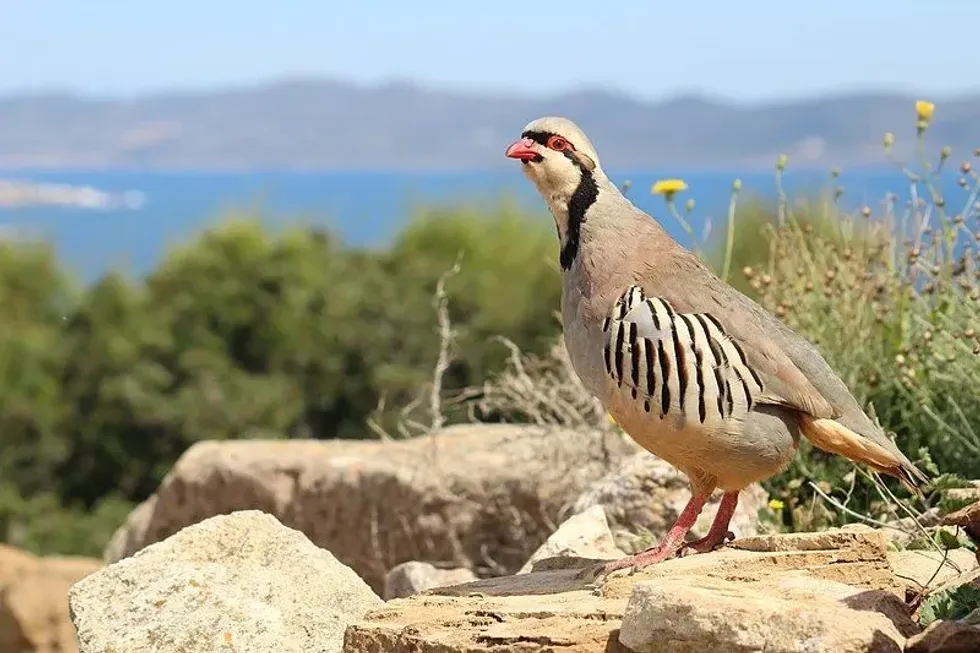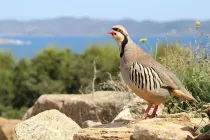Fun Chukar Facts For Kids

Chukars are medium-sized, sandy-brown, game birds that belong to the family of pheasants. With a similar appearance to a partridge, the species was earlier mistaken to be of the same species as rock partridge, and other variety of partridges.
The chukar partridge, or Alectoris chukar, lives in small groups of ten to thirty birds. These birds are native to dry grasslands and sandy scrublands of the Middle East, and South Asian countries.
The stout, short-legged, chukar birds belonging to the order Galliformes family Phasianidae, are common game birds in many countries. Their agile running speed through rocky slopes and rough terrain has gained them the name of ‘devil bird’.
The family Phasianidae includes several other species. Other species in this family are pheasants and partridges like jungle-fowl, spurfowls or francolins, peafowl, quail, species of monals, etc.
The chukar partridge diet in all its ranges mainly includes seeds and green vegetation depending on the season. In some places, the ground-dwelling chukar birds also eat mall insects.
These plump partridges have a bright red beak, gray-brown feathers, and black bands on the wing feathers. A distinct black band runs like a chevron from one eye to the other through the neck like a necklace.
You may also check out the fact files on red-breasted nuthatch facts and chimney swift facts from Kidadl.
Chukar Interesting Facts
What type of animal is a chukar?
The chukar Alectoris, or the chukar partridge, is a type of bird belonging to the Phasianidae pheasant family. It is a land fowl native to Asia and the Middle East and is now also found in parts of North America and Canada. Chukar hunting is a common sport in many places.
What class of animal does a chukar belong to?
A chukar is a bird that falls under the class Aves. It is a common game bird and is hunted for meat.
How many chukars are there in the world?
The estimated chukar population is about 9 million birds. These populations include wild populations worldwide in all the nations where they are found.
Where does a chukar live?
Chukars are native to Asia and the Middle East including countries like India, Nepal, China, Bulgaria, and Greece. Their populations have spread to parts of North America, Hawaii, North Africa’s Africa on the Sinai Peninsula, and New Zealand.
This species of partridge prefer nesting in rocky or open grassy hillsides, arid lands with bush cover, and scrublands. In the Indian subcontinent, these birds inhabit the inner ranges of the western Himalayas. The range stretches to Nepal.
Their nests are typically built using feathers and dry grass. Chukar nests tend to stay hidden under rocks on mountain slopes or bushes where is difficult for predators to spot their eggs and chicks.
What is a chukar's habitat?
Chukar habitat differs according to the topography. In semi-desert regions, they nest under desert shrubs. In North American elevated shrublands and rugged rocky hillsides, these birds nest usually under bushes like golden bush, desert tea, or sagebrush. Here seeds are plentiful to meet their dietary requirements.
Chukar partridge from the Phasianidae family do not like moist or cold weather. They prefer nesting in low-altitude locations. They may be found in deserts with scarce vegetation, even barren plateaus, or dry pasture lands. Chukars are non-migratory birds. In particularly rough or hot weather, chukars may enter nearby rural settlements.
Who do chukars live with?
The Alectoris chukar birds live in small groups or coveys of 10-40 birds in the wild. Chukars forage during the day on the ground.
These birds prefer to run than fly when they feel threatened. The social group, or covey, usually consists of several adults and their chicks. Some of the largest chukar partridge groups are found close to water sources.
These game birds do not migrate. In case of cold weather, they just shift to a lower altitude. Their flight is restricted to only short distances when traveling downhill or chased by predators or humans. When traveling through rough, rocky, or steep terrain, these birds hop rather than taking a flight.
How long does a chukar live?
Chukar Alectoris birds live for three to five years.
How do they reproduce?
Chukars are monogamous birds. They mate with one partner. The North American chukar bird breeding season starts during the summer month of April and stretches till June.
The males protect the females and their nesting territories from competitors. Males usually reach sexual maturity before females. The females reach reproductive maturity in little more than a year.
Before they build their nests, the pairs form as soon as February starting with the courtship displays. The male performs its moves by tilting its head and showing off the barred wings. If the female is willing to mate, it participates in what is known as a ‘tidbitting' display, by pecking at different objects.
Nests are simple and built-in dry areas with open, hilly outcrops. The nests are built with feathers and leaves in a poorly lined or cushioned ground scrape. An average clutch of chukar eggs is eight to twenty numbers.
These birds usually produce a single clutch every season. Sometimes, some females also have two consecutive clutches known as double-clutching. The eggs take about twenty-five days to incubate.
Like chicks of hens, the hatchlings are ready to venture out of the nest shortly after hatching. The chicks fledge in a couple of weeks and are ready for their first flight. Chukar chicks take about three months to attain full size.
What is their conservation status?
Populations of the Alectoris chukar species are not globally threatened and their conservation status is of Least Concern according to the IUCN. In most countries, the populations are either stable or rising. Some native populations may be suffering due to chukar bird hunting, and habitat loss.
Chukars’ inability to fly long distances with their short wings and plump bodies makes them easy game birds. Humans have been hunting chukar partridges for a long time. These birds were introduced to North American habitats only for their game bird status.
In some areas, the population of chukar partridges is affected by global climatic change. Increased seasonal storms, extreme heat and cold, may affect the chukar population like most of the other wildlife species.
Disease transmission of the wild chukar partridge population from domestic chicken is another rising concern. The remote habitat of these birds makes chukar bird hunting considerably difficult, compared to many other game birds of the same family.
As a conservation effort to keep chukars in their ranges in some of its North American habitats, rainwater catchment systems and fortifying existing eater sources have been carried out.
The robust chukars are often hunted by predators like wild dogs, coyotes, bobcats, and lynx in North America. Birds of prey including hawks and owls also prey on these easy targets.
Chukar Fun Facts
What do chukars look like?

Chukars look similar to the common gray partridges but more colorful. These game birds have plump bodies covered with sandy-brown and buff feathers. Wing feathers are banded with black. Their short legs give them enough strength to run fast.
The head is small and round. These birds have a bright red bill. The tail is short. The vertical black-banded wings are broad and rounded.
A dark band is visible around the cheek, neck, and eyes, giving it a masked appearance. The male birds are slightly bigger than the females with chunkier heads. The female's appearance is more refined with a smaller head. The female birds often have spurs on their legs.
The mixed hues of the feathers including white, black, chestnut, gray, with a red bill, and a black band forms a contrasting look. Their color may slightly vary from a brighter to a paler look depending on the geographical location.
How cute are they?
Chukar partridges look plump, cute, and fluffy but as they are wild birds they cannot be cuddled, just like ani birds.
How do they communicate?
Chukar birds are vocal with a range of calls. There are different chukar calls for aggression, alarm, social calls, and other emotions. When a handful of chukar populations gets together, the low-intensity chukar sound can become intensified.
When frightened, the chukar calls are exploding, ear-piercing squeals. The common vocalization calls are low-intensity chucks that sound like ‘chuck-a-ra’. These calls gained these birds their name and the chukar pronunciation.
How big is a chukar?
Compared to a bald eagle that’s about 36 in (91.4 cm) long, a chukar is twice shorter with the length of 13 in (33 cm). Bald eagles weigh up to fourteen pounds and chukars weigh around one pound. So, a chukar is fourteen times lighter than a bald eagle.
If the comparison is between chukar vs quail, both the bird species look quite similar. All being common game birds, they are of somewhat similar sizes. Compared to a colorful California quail chukar is a bit larger.
How fast can a chukar fly?
Chukars seldom fly. These birds walk, run, and hop across their rocky, sandy, and rough habitat. A chukar’s speed is around 12.4 mph (20 kph).
How much does a chukar weigh?
Chukars weigh around 1lb (500g).
What are the male and female names of the species?
Male and female chukars may be called a cock and hen respectively.
What would you call a baby chukar?
A baby chukar is called a hatchling, nestling, or a fledgling.
What do they eat?
Chukars are mostly diurnal, ground foragers. These birds keep moving through their native range as they forage on seeds like sunflower, mustard, pinyon pine, berries, grasses. Although, mostly herbivores some chukars also eat small insects. Mountain slopes, scrublands, cultivated lands are their favorite foraging grounds. During summers, large populations of these birds move close to water sources.
Are they aggressive?
Although chukar quails are mostly herbivores with the occasional inclusion of insects in their diet, they are cannibals. This species cannot live with each other in closed cages.
Similar traits are noticed among other Phasianidae family members like partridges, quails, and pheasants. In confinement, these birds resort to cannibalism. They pull tail feathers, peck with their beaks, and attack other birds in their pen.
In the wild, they live in small groups called a covey. However, it’s only during the winter months the chukar partridges tolerate one another and live harmoniously in coveys. As the breeding season arrives in spring, the males become extremely aggressive.
Would they make a good pet?
No, chukars are not good pet birds as they are wild animals.
Did you know...
Chukars have bold markings in their feathers but are difficult to spot in their native habitat due to their body color. It is easier to locate a chukar call to spot a bird.
The chukar was introduced in California as a game bird for hunting recreation. Now, it is popular gourmet food.
Chukar eggs are said to be tasty and slightly sweet.
The chukar is a national symbol of Pakistan and the country’s national bird.
In Indian and Pakistani cultures, chukar sometimes symbolizes strong and often unreturned love. The bird is thought to be in love with the moon and stare at it frequently.
During the breeding season, when the male birds become aggressive, chukars are used as fighting birds.
How do chukars get enough water?
Some of chukar partridge’s native homes are in dry countries. The birds take advantage of water sources like ponds, rivers, and even mineshafts that are more than ten feet deep. Chukars bathe not with water but with dust every day to keep their feathers in good shape.
What habitat do chukars prefer?
Chukars prefer staying on hillsides that have a gentle slope of are twenty to thirty degrees from the flat ground. The range of the North American birds of this species includes the Rocky Mountains, The Great Basin, Sierra Nevada, and the Cascade Range, the Mojave Desert, Death Valley, Central Utah.
They can be found in elevations as high as twelve thousand feet in the White Mountains.
Here at Kidadl, we have carefully created lots of interesting family-friendly animal facts for everyone to discover! For more relatable content, check out these black-capped chickadee facts and killdeer facts!
You can even occupy yourself at home by coloring in one of our free printable chukar coloring pages.
We Want Your Photos!
More for You
See All
Bachelor of Arts specializing in Linguistics

Martha MartinsBachelor of Arts specializing in Linguistics
Martha is a full-time creative writer, content strategist, and aspiring screenwriter who communicates complex thoughts and ideas effectively. She has completed her Bachelor's in Linguistics from Nasarawa State University. As an enthusiast of public relations and communication, Martha is well-prepared to substantially impact your organization as your next content writer and strategist. Her dedication to her craft and commitment to delivering high-quality work enables her to create compelling content that resonates with audiences.
Postgraduate Diploma in Management

Sakshi RaturiPostgraduate Diploma in Management
Sakshi has experience in marketing strategy, social media planning, and recruiting industry experts for capstone projects, she has displayed a commitment to enhancing their skills and knowledge. She has won multiple awards, including a Certificate of Appreciation for Creative Writing and a Certificate of Merit for Immaculate Turut, and is always seeking new opportunities to grow and develop.
Disclaimer
1) Kidadl is independent and to make our service free to you the reader we are supported by advertising. We hope you love our recommendations for products and services! What we suggest is selected independently by the Kidadl team. If you purchase using the Buy Now button we may earn a small commission. This does not influence our choices. Prices are correct and items are available at the time the article was published but we cannot guarantee that on the time of reading. Please note that Kidadl is a participant in the Amazon Services LLC Associates Program, an affiliate advertising program designed to provide a means for sites to earn advertising fees by advertising and linking to Amazon. We also link to other websites, but are not responsible for their content.
2) At Kidadl, we strive to recommend the very best activities and events. We will always aim to give you accurate information at the date of publication - however, information does change, so it’s important you do your own research, double-check and make the decision that is right for your family. We recognise that not all activities and ideas are appropriate for all children and families or in all circumstances. Our recommended activities are based on age but these are a guide. We recommend that these ideas are used as inspiration, that ideas are undertaken with appropriate adult supervision, and that each adult uses their own discretion and knowledge of their children to consider the safety and suitability. Kidadl cannot accept liability for the execution of these ideas, and parental supervision is advised at all times, as safety is paramount. Anyone using the information provided by Kidadl does so at their own risk and we can not accept liability if things go wrong.
3) Because we are an educational resource, we have quotes and facts about a range of historical and modern figures. We do not endorse the actions of or rhetoric of all the people included in these collections, but we think they are important for growing minds to learn about under the guidance of parents or guardians.







